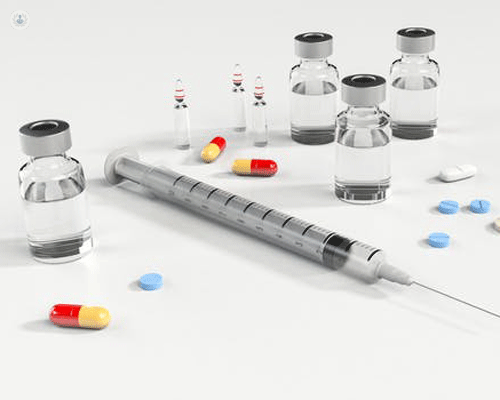Lidocaine administration
Dr Kavita Poply - Pain medicine
Created on: 11-13-2012
Updated on: 09-19-2023
Edited by: Kate Forristal
What are they?
Lidocaine is an anti-inflammatory drug. It has an analgesic effect and, contrarily to other similar active ingredients, it lasts longer and starts working sooner (it takes roughly 20 minutes). Lidocaine acts on the neurons by blocking the transmission of the stimulus for pain. Once it starts wearing off, it is processed by the kidneys and expelled with urine.

What are they for?
Lidocaine can be used as an anaesthetic or as antiarrhythmic agent.
It is mainly administered as infiltration therapy of the soft tissues to treat particularly acute episodes of bursitis, tennis elbow, rheumatoid arthritis, gout and post-traumatic osteoarthritis. If delivered intravenously, it can prevent cardiac conditions such as a heart attack.
Lidocaine injections are also done during minimally invasive dental procedures (dental extractions or fillings) and aesthetic procedures (filler or collagen injections). Finally, it can be given to women during labour to help with the pain caused by the contractions.
What does it involve?
A lidocaine injection is often coupled with other active ingredients and injected intravenously or subcutaneously, based on what area you need to treat. When delivered intravenously, the treatment lasts roughly one hour to one hour and a half, during which the doctor will monitor your heartbeat and blood pressure to avoid any potential risks. As mentioned before, this drug can also be used to treat arrhythmias.
How can I prepare for it?
Before getting started on lidocaine injection therapy, you’ll need to tell your doctor if you have any specific conditions of the kidneys, heart and liver, if you’re pregnant or if you’re breastfeeding. There is no need for preparation before a lidocaine injection. All you need to do is disinfect your skin and make sure all the tools are sterile.
Post-procedure progress
There are no specific post-injection patient care guidelines. You shouldn’t take any other medication without talking to your GP first, as there may be an interaction between the drugs which could lead to various side effects. In case you notice some swelling, breathing problems, or spasms you should see your doctor as soon as possible.
